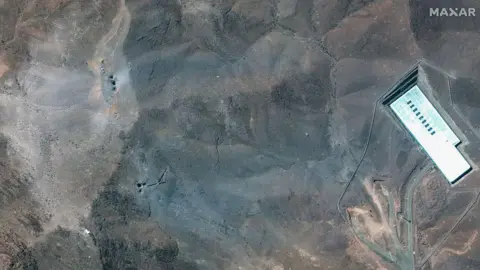Donald Trump and his top officials pushed out the leaked information reports, and the US strike on Iran said he returned the nuclear program in a few months.
Trump gave a speech at the NATO summit in Hague on Wednesday, followed by a “virtual delusion” of Iran’s nuclear capacity due to a strike, and reset the atomic program for decades.
Defense Minister Pete Hegseth, who was at the summit, said the preliminary pentagon evaluation consisted of “low trust” and the FBI was investigating leaks.
The source, who is familiar with the initial report on bombings on Tuesday and Saturday, said that the BBC’s US partner CBS AIRAN’s rich uranium stockpiles were not removed.
They added that this strike has reinstated the nuclear program in this country even after a few months.
According to the report, strikes on the severely enhanced enhanced facilities of Fordo and Natanz blocked the entrance but could not destroy the underground structure.
The officials who are accustomed to the evaluation of leaked defense intelligence agencies warned that they could be initial evaluation as they could get more information about the site.
The Defense Intelligence Service is the Department of Defense’s own institution that specializes in military information to support the operation. It collects a large amount of technology intelligence but is different from other institutions such as the CIA.
There are 18 intelligence agencies in the United States, and sometimes generate conflicting reports depending on their mission and specialty. For example, the US information community still does not agree with the origin of Covid-19.
Wednesday, while sitting with NATO’s Mark Rutte, Trump first admitted uncertainty.
But he went further in his evaluation, saying, “It was very serious and was extinguished.”
Trump asked if Iran would resume nuclear activity again: “Of course, I don’t have to worry about it. It’s gone for several years.”
Trump later likened a strike to the bombing of Hiroshima in the United States at the end of World War II.
“I don’t want to use Hiroshima’s example, and I don’t want to use Nagasaki’s example, but it was essentially the same -it was over,” he said.
The US president was next to Secretary of State Marco Rubio and Secretary of Defense Pethes, reflecting the skepticism of leaked information.
HegSeth insisted that the leak was politically motivated and the bomb was “exactly where to be.”
He added: He was characterized by “completely false”.
Rubio also questioned the reliability of the leaked report, and the contents were distorted in the media and marked the leaker as “professional stab”.
 Reuters
ReutersThe preliminary evaluation also pointed out that some of Iran’s rich uranium stockpiles moved before the attack.
According to sources that are familiar with it, Iran’s centrifugal separation remains a “untrusted” state with a limited destruction of ground buildings.
Two nuclear facilities were blocked and some infrastructure was damaged, but most of the deeper installations survived the explosion.
In US information terms, “low trust” generally indicates that information is not properly supplied, fragmented or uncertain. It is less reliable than the “normal” or “high trust”.
HegSeth’s comment on the report of “low trust” is tentative and the results can change when more details appear.
The United States hit three nuclear scenes in Aran, grapes, Nathanz, and Isfahan.
Although certain ammunition used in this attack was not confirmed, the large -scale weapon penetration (MOP) of 30,000 pounds (14,000 kg) was thought to be the only weapon to destroy Iran’s underground concentrated facilities.
Tehran always said that nuclear programs are for peaceful purposes.
 Maxar Technologies through satellite image (c) 2025 Getty image
Maxar Technologies through satellite image (c) 2025 Getty imageFor several hours following the Saturday strike, General Dan Cain, co -chief, said that it would take time to evaluate the damage of the facility to reporters.
But he added, “All three were very seriously damaged and destroyed.” The satellite image shows six fresh craters around the Fordo Nuclear site, gray dust and the debris.
But it is not clear in the latest satellite images. But it’s not clear how damaged the site is under the surface.
Hassan Abedini, the deputy director of Iranian broadcasters, said that the US aimed for three “electricity,” and Iran said, “The data has already been off and has not been hit hard.”
Meanwhile, all of us and Israeli officials welcomed the mission with success.



